Economics: Macro-Problem 2 (Part 2) - Money, Banking, and Inflation
VerifiedAdded on 2019/10/18
|12
|2244
|250
Homework Assignment
AI Summary
This economics assignment addresses macroeconomic challenges in Hatboro, focusing on inflation and the role of monetary policy. The student analyzes five proposed solutions from the Board of Governors, evaluating the impact of reserve requirements, discount rates, open market operations, alternative policies, and a "two-fisted" approach. The analysis includes the effects on money supply and economic growth, supported by graphs and balance sheets. The student recommends the discount rate increase as the best solution and provides a detailed explanation of its impact. A bonus problem explores the effects of an 18% inflation rate on lending, borrowing, unemployment, and real wages, followed by a discussion of fiscal policy difficulties and the effectiveness of monetary policy. The assignment demonstrates an understanding of monetary policy tools and their effects on the economy.
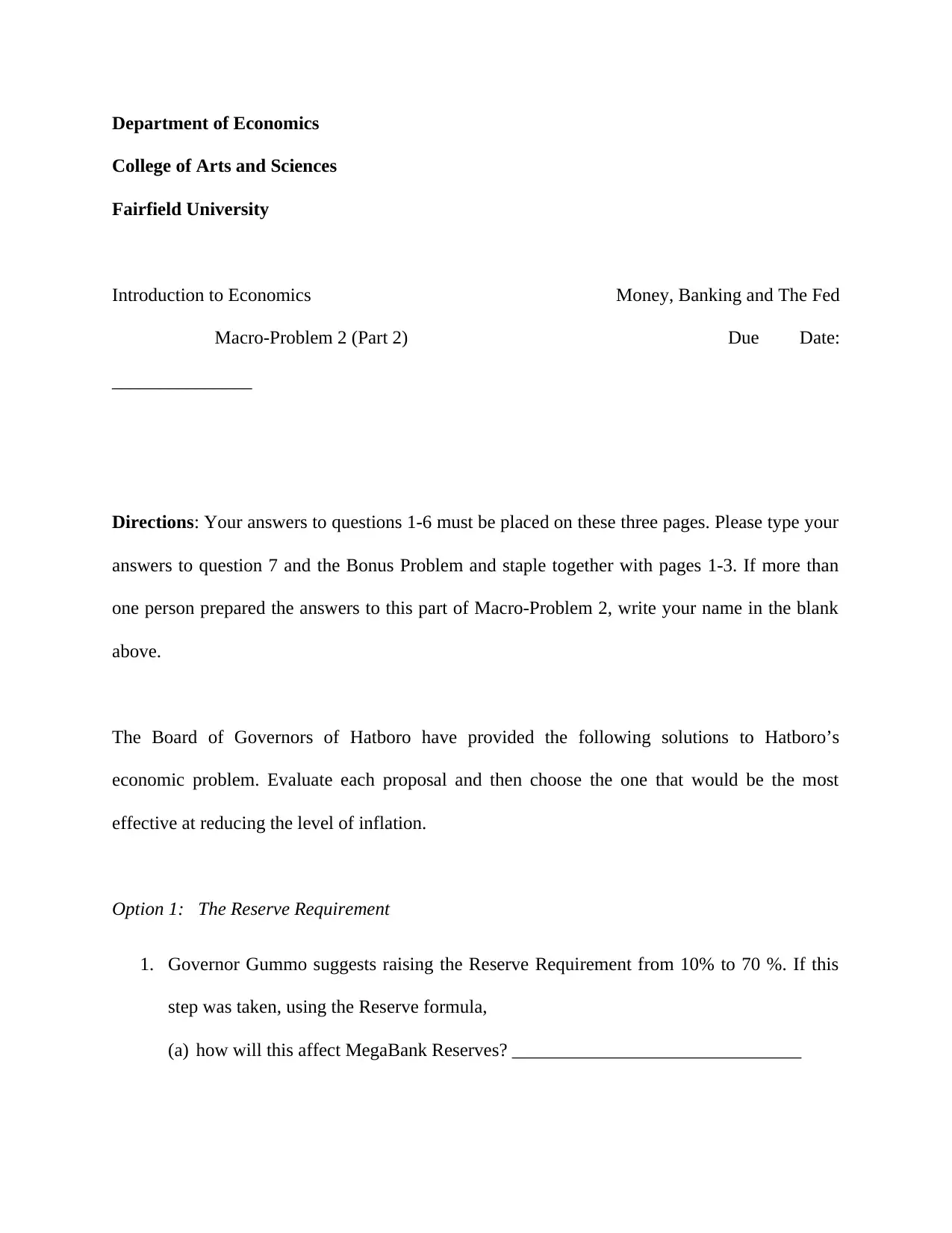
Department of Economics
College of Arts and Sciences
Fairfield University
Introduction to Economics Money, Banking and The Fed
Macro-Problem 2 (Part 2) Due Date:
_______________
Directions: Your answers to questions 1-6 must be placed on these three pages. Please type your
answers to question 7 and the Bonus Problem and staple together with pages 1-3. If more than
one person prepared the answers to this part of Macro-Problem 2, write your name in the blank
above.
The Board of Governors of Hatboro have provided the following solutions to Hatboro’s
economic problem. Evaluate each proposal and then choose the one that would be the most
effective at reducing the level of inflation.
Option 1: The Reserve Requirement
1. Governor Gummo suggests raising the Reserve Requirement from 10% to 70 %. If this
step was taken, using the Reserve formula,
(a) how will this affect MegaBank Reserves? _______________________________
College of Arts and Sciences
Fairfield University
Introduction to Economics Money, Banking and The Fed
Macro-Problem 2 (Part 2) Due Date:
_______________
Directions: Your answers to questions 1-6 must be placed on these three pages. Please type your
answers to question 7 and the Bonus Problem and staple together with pages 1-3. If more than
one person prepared the answers to this part of Macro-Problem 2, write your name in the blank
above.
The Board of Governors of Hatboro have provided the following solutions to Hatboro’s
economic problem. Evaluate each proposal and then choose the one that would be the most
effective at reducing the level of inflation.
Option 1: The Reserve Requirement
1. Governor Gummo suggests raising the Reserve Requirement from 10% to 70 %. If this
step was taken, using the Reserve formula,
(a) how will this affect MegaBank Reserves? _______________________________
Secure Best Marks with AI Grader
Need help grading? Try our AI Grader for instant feedback on your assignments.
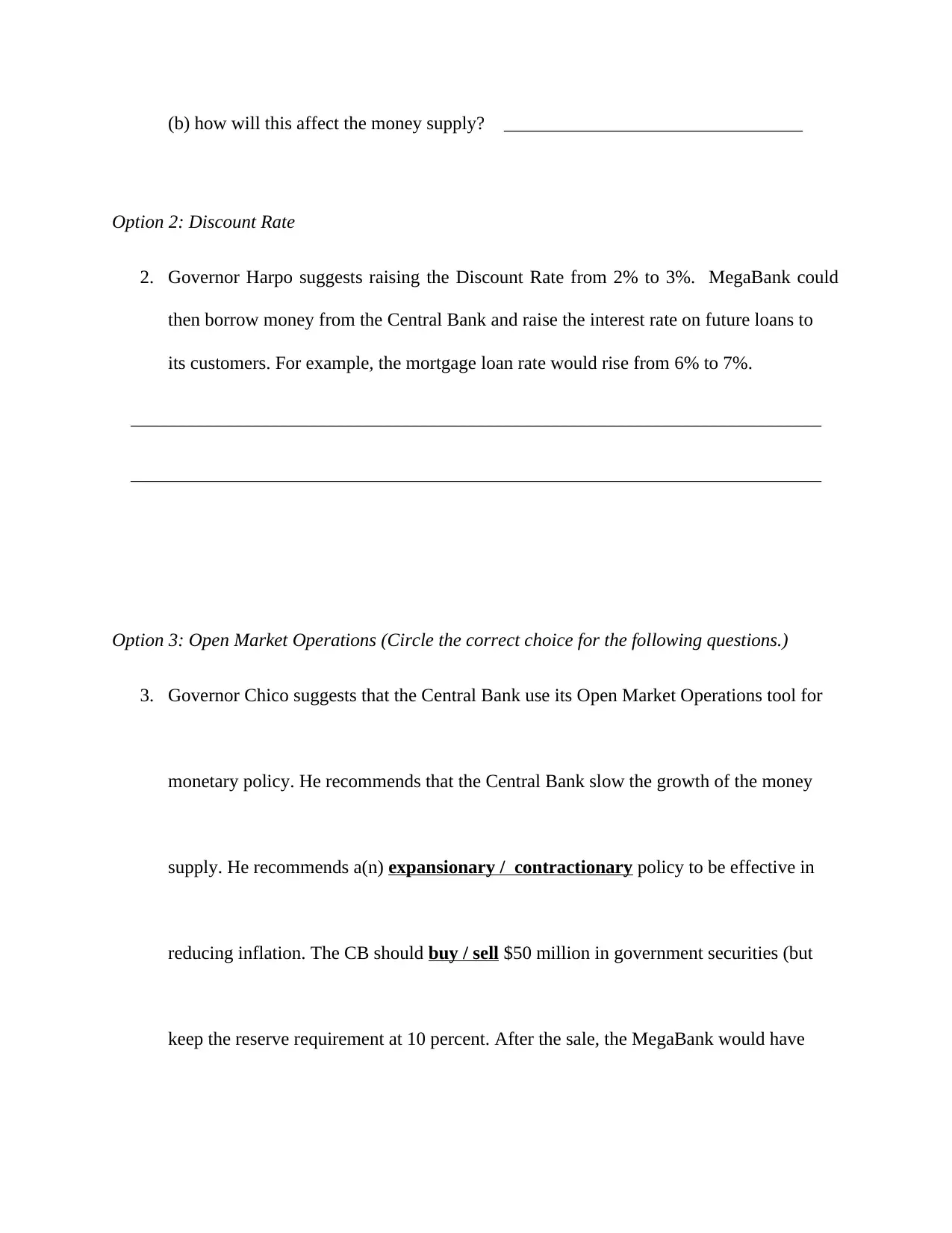
(b) how will this affect the money supply? ________________________________
Option 2: Discount Rate
2. Governor Harpo suggests raising the Discount Rate from 2% to 3%. MegaBank could
then borrow money from the Central Bank and raise the interest rate on future loans to
its customers. For example, the mortgage loan rate would rise from 6% to 7%.
__________________________________________________________________________
__________________________________________________________________________
Option 3: Open Market Operations (Circle the correct choice for the following questions.)
3. Governor Chico suggests that the Central Bank use its Open Market Operations tool for
monetary policy. He recommends that the Central Bank slow the growth of the money
supply. He recommends a(n) expansionary / contractionary policy to be effective in
reducing inflation. The CB should buy / sell $50 million in government securities (but
keep the reserve requirement at 10 percent. After the sale, the MegaBank would have
Option 2: Discount Rate
2. Governor Harpo suggests raising the Discount Rate from 2% to 3%. MegaBank could
then borrow money from the Central Bank and raise the interest rate on future loans to
its customers. For example, the mortgage loan rate would rise from 6% to 7%.
__________________________________________________________________________
__________________________________________________________________________
Option 3: Open Market Operations (Circle the correct choice for the following questions.)
3. Governor Chico suggests that the Central Bank use its Open Market Operations tool for
monetary policy. He recommends that the Central Bank slow the growth of the money
supply. He recommends a(n) expansionary / contractionary policy to be effective in
reducing inflation. The CB should buy / sell $50 million in government securities (but
keep the reserve requirement at 10 percent. After the sale, the MegaBank would have
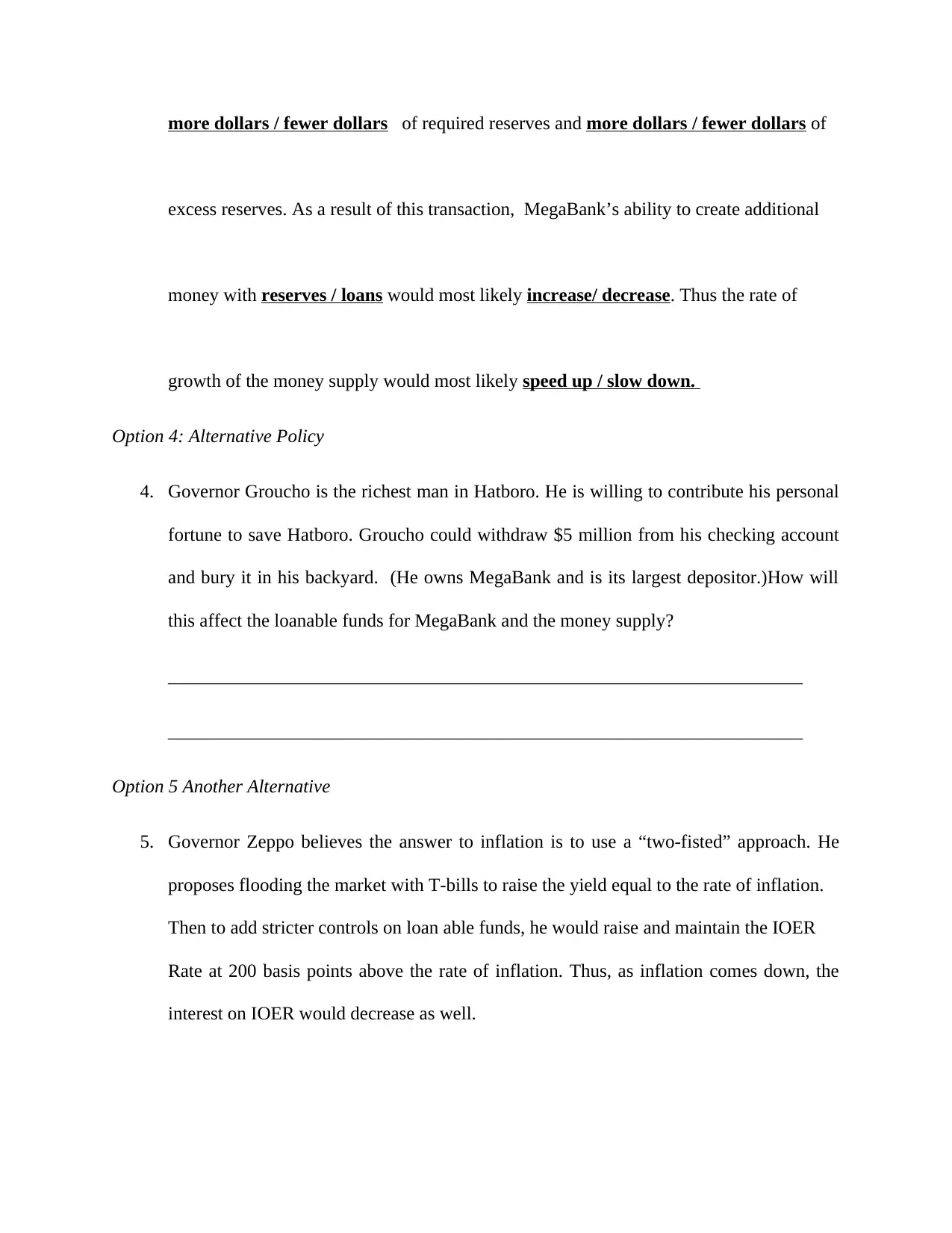
more dollars / fewer dollars of required reserves and more dollars / fewer dollars of
excess reserves. As a result of this transaction, MegaBank’s ability to create additional
money with reserves / loans would most likely increase/ decrease. Thus the rate of
growth of the money supply would most likely speed up / slow down.
Option 4: Alternative Policy
4. Governor Groucho is the richest man in Hatboro. He is willing to contribute his personal
fortune to save Hatboro. Groucho could withdraw $5 million from his checking account
and bury it in his backyard. (He owns MegaBank and is its largest depositor.)How will
this affect the loanable funds for MegaBank and the money supply?
____________________________________________________________________
____________________________________________________________________
Option 5 Another Alternative
5. Governor Zeppo believes the answer to inflation is to use a “two-fisted” approach. He
proposes flooding the market with T-bills to raise the yield equal to the rate of inflation.
Then to add stricter controls on loan able funds, he would raise and maintain the IOER
Rate at 200 basis points above the rate of inflation. Thus, as inflation comes down, the
interest on IOER would decrease as well.
excess reserves. As a result of this transaction, MegaBank’s ability to create additional
money with reserves / loans would most likely increase/ decrease. Thus the rate of
growth of the money supply would most likely speed up / slow down.
Option 4: Alternative Policy
4. Governor Groucho is the richest man in Hatboro. He is willing to contribute his personal
fortune to save Hatboro. Groucho could withdraw $5 million from his checking account
and bury it in his backyard. (He owns MegaBank and is its largest depositor.)How will
this affect the loanable funds for MegaBank and the money supply?
____________________________________________________________________
____________________________________________________________________
Option 5 Another Alternative
5. Governor Zeppo believes the answer to inflation is to use a “two-fisted” approach. He
proposes flooding the market with T-bills to raise the yield equal to the rate of inflation.
Then to add stricter controls on loan able funds, he would raise and maintain the IOER
Rate at 200 basis points above the rate of inflation. Thus, as inflation comes down, the
interest on IOER would decrease as well.
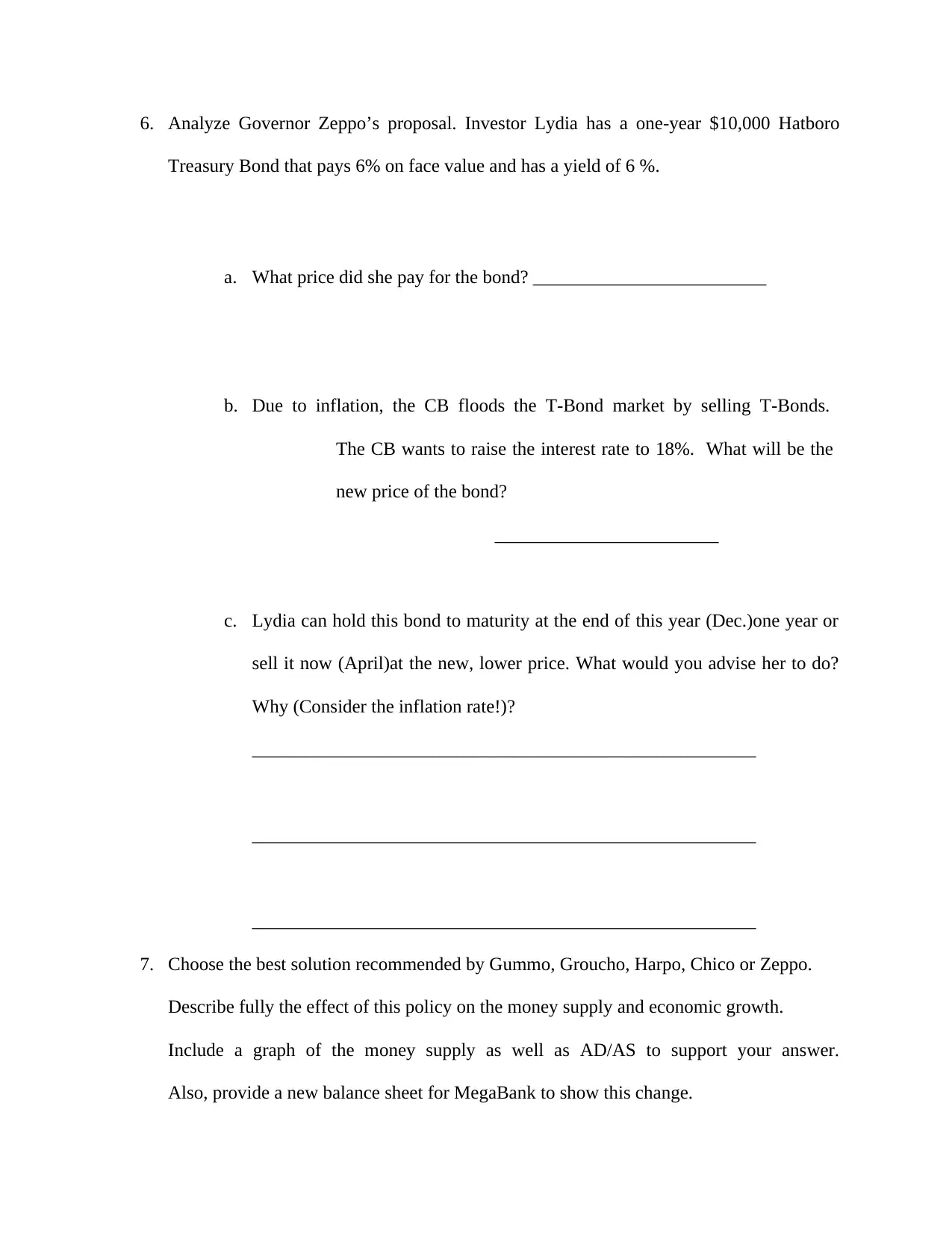
6. Analyze Governor Zeppo’s proposal. Investor Lydia has a one-year $10,000 Hatboro
Treasury Bond that pays 6% on face value and has a yield of 6 %.
a. What price did she pay for the bond? _________________________
b. Due to inflation, the CB floods the T-Bond market by selling T-Bonds.
The CB wants to raise the interest rate to 18%. What will be the
new price of the bond?
________________________
c. Lydia can hold this bond to maturity at the end of this year (Dec.)one year or
sell it now (April)at the new, lower price. What would you advise her to do?
Why (Consider the inflation rate!)?
______________________________________________________
______________________________________________________
______________________________________________________
7. Choose the best solution recommended by Gummo, Groucho, Harpo, Chico or Zeppo.
Describe fully the effect of this policy on the money supply and economic growth.
Include a graph of the money supply as well as AD/AS to support your answer.
Also, provide a new balance sheet for MegaBank to show this change.
Treasury Bond that pays 6% on face value and has a yield of 6 %.
a. What price did she pay for the bond? _________________________
b. Due to inflation, the CB floods the T-Bond market by selling T-Bonds.
The CB wants to raise the interest rate to 18%. What will be the
new price of the bond?
________________________
c. Lydia can hold this bond to maturity at the end of this year (Dec.)one year or
sell it now (April)at the new, lower price. What would you advise her to do?
Why (Consider the inflation rate!)?
______________________________________________________
______________________________________________________
______________________________________________________
7. Choose the best solution recommended by Gummo, Groucho, Harpo, Chico or Zeppo.
Describe fully the effect of this policy on the money supply and economic growth.
Include a graph of the money supply as well as AD/AS to support your answer.
Also, provide a new balance sheet for MegaBank to show this change.
Secure Best Marks with AI Grader
Need help grading? Try our AI Grader for instant feedback on your assignments.
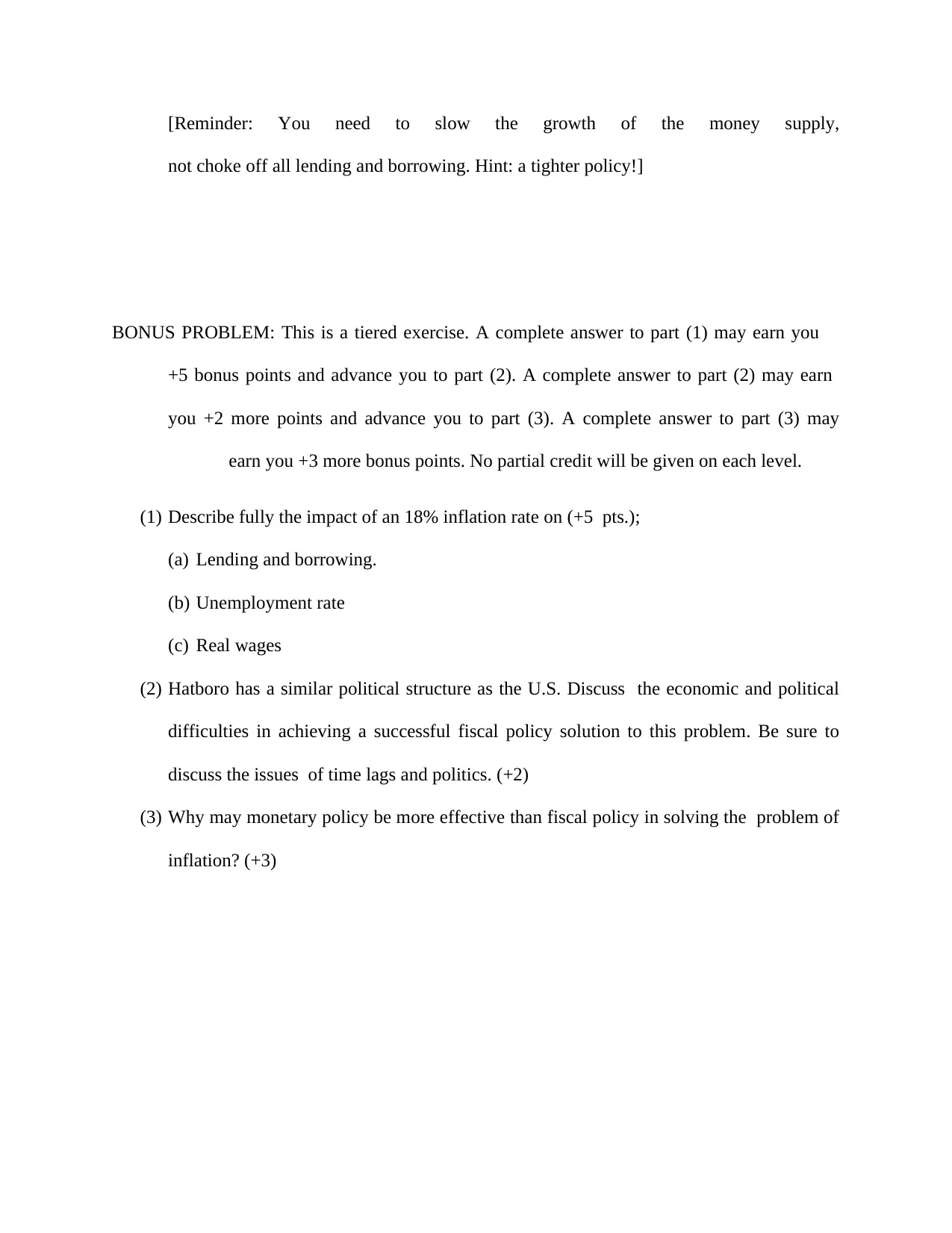
[Reminder: You need to slow the growth of the money supply,
not choke off all lending and borrowing. Hint: a tighter policy!]
BONUS PROBLEM: This is a tiered exercise. A complete answer to part (1) may earn you
+5 bonus points and advance you to part (2). A complete answer to part (2) may earn
you +2 more points and advance you to part (3). A complete answer to part (3) may
earn you +3 more bonus points. No partial credit will be given on each level.
(1) Describe fully the impact of an 18% inflation rate on (+5 pts.);
(a) Lending and borrowing.
(b) Unemployment rate
(c) Real wages
(2) Hatboro has a similar political structure as the U.S. Discuss the economic and political
difficulties in achieving a successful fiscal policy solution to this problem. Be sure to
discuss the issues of time lags and politics. (+2)
(3) Why may monetary policy be more effective than fiscal policy in solving the problem of
inflation? (+3)
not choke off all lending and borrowing. Hint: a tighter policy!]
BONUS PROBLEM: This is a tiered exercise. A complete answer to part (1) may earn you
+5 bonus points and advance you to part (2). A complete answer to part (2) may earn
you +2 more points and advance you to part (3). A complete answer to part (3) may
earn you +3 more bonus points. No partial credit will be given on each level.
(1) Describe fully the impact of an 18% inflation rate on (+5 pts.);
(a) Lending and borrowing.
(b) Unemployment rate
(c) Real wages
(2) Hatboro has a similar political structure as the U.S. Discuss the economic and political
difficulties in achieving a successful fiscal policy solution to this problem. Be sure to
discuss the issues of time lags and politics. (+2)
(3) Why may monetary policy be more effective than fiscal policy in solving the problem of
inflation? (+3)
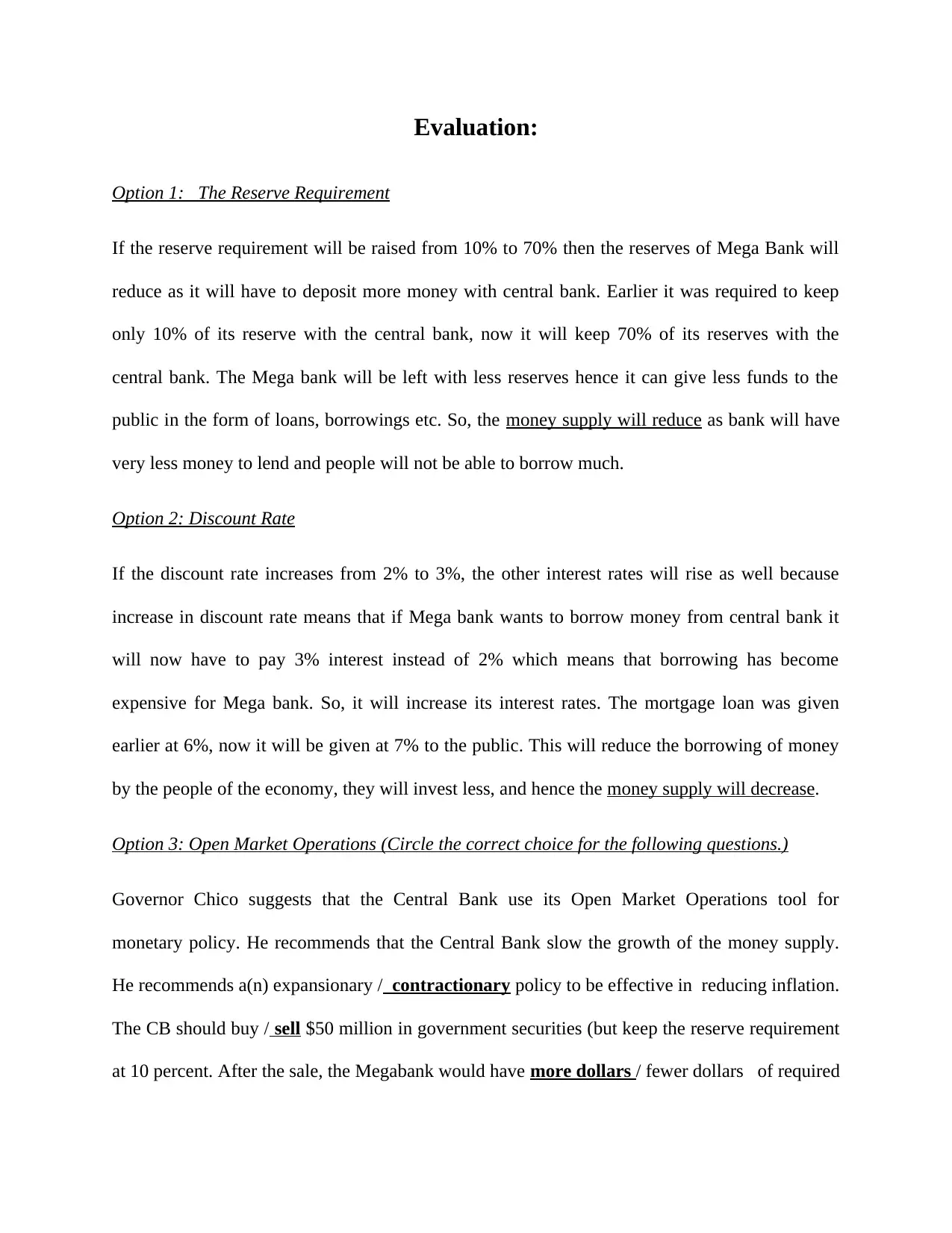
Evaluation:
Option 1: The Reserve Requirement
If the reserve requirement will be raised from 10% to 70% then the reserves of Mega Bank will
reduce as it will have to deposit more money with central bank. Earlier it was required to keep
only 10% of its reserve with the central bank, now it will keep 70% of its reserves with the
central bank. The Mega bank will be left with less reserves hence it can give less funds to the
public in the form of loans, borrowings etc. So, the money supply will reduce as bank will have
very less money to lend and people will not be able to borrow much.
Option 2: Discount Rate
If the discount rate increases from 2% to 3%, the other interest rates will rise as well because
increase in discount rate means that if Mega bank wants to borrow money from central bank it
will now have to pay 3% interest instead of 2% which means that borrowing has become
expensive for Mega bank. So, it will increase its interest rates. The mortgage loan was given
earlier at 6%, now it will be given at 7% to the public. This will reduce the borrowing of money
by the people of the economy, they will invest less, and hence the money supply will decrease.
Option 3: Open Market Operations (Circle the correct choice for the following questions.)
Governor Chico suggests that the Central Bank use its Open Market Operations tool for
monetary policy. He recommends that the Central Bank slow the growth of the money supply.
He recommends a(n) expansionary / contractionary policy to be effective in reducing inflation.
The CB should buy / sell $50 million in government securities (but keep the reserve requirement
at 10 percent. After the sale, the Megabank would have more dollars / fewer dollars of required
Option 1: The Reserve Requirement
If the reserve requirement will be raised from 10% to 70% then the reserves of Mega Bank will
reduce as it will have to deposit more money with central bank. Earlier it was required to keep
only 10% of its reserve with the central bank, now it will keep 70% of its reserves with the
central bank. The Mega bank will be left with less reserves hence it can give less funds to the
public in the form of loans, borrowings etc. So, the money supply will reduce as bank will have
very less money to lend and people will not be able to borrow much.
Option 2: Discount Rate
If the discount rate increases from 2% to 3%, the other interest rates will rise as well because
increase in discount rate means that if Mega bank wants to borrow money from central bank it
will now have to pay 3% interest instead of 2% which means that borrowing has become
expensive for Mega bank. So, it will increase its interest rates. The mortgage loan was given
earlier at 6%, now it will be given at 7% to the public. This will reduce the borrowing of money
by the people of the economy, they will invest less, and hence the money supply will decrease.
Option 3: Open Market Operations (Circle the correct choice for the following questions.)
Governor Chico suggests that the Central Bank use its Open Market Operations tool for
monetary policy. He recommends that the Central Bank slow the growth of the money supply.
He recommends a(n) expansionary / contractionary policy to be effective in reducing inflation.
The CB should buy / sell $50 million in government securities (but keep the reserve requirement
at 10 percent. After the sale, the Megabank would have more dollars / fewer dollars of required
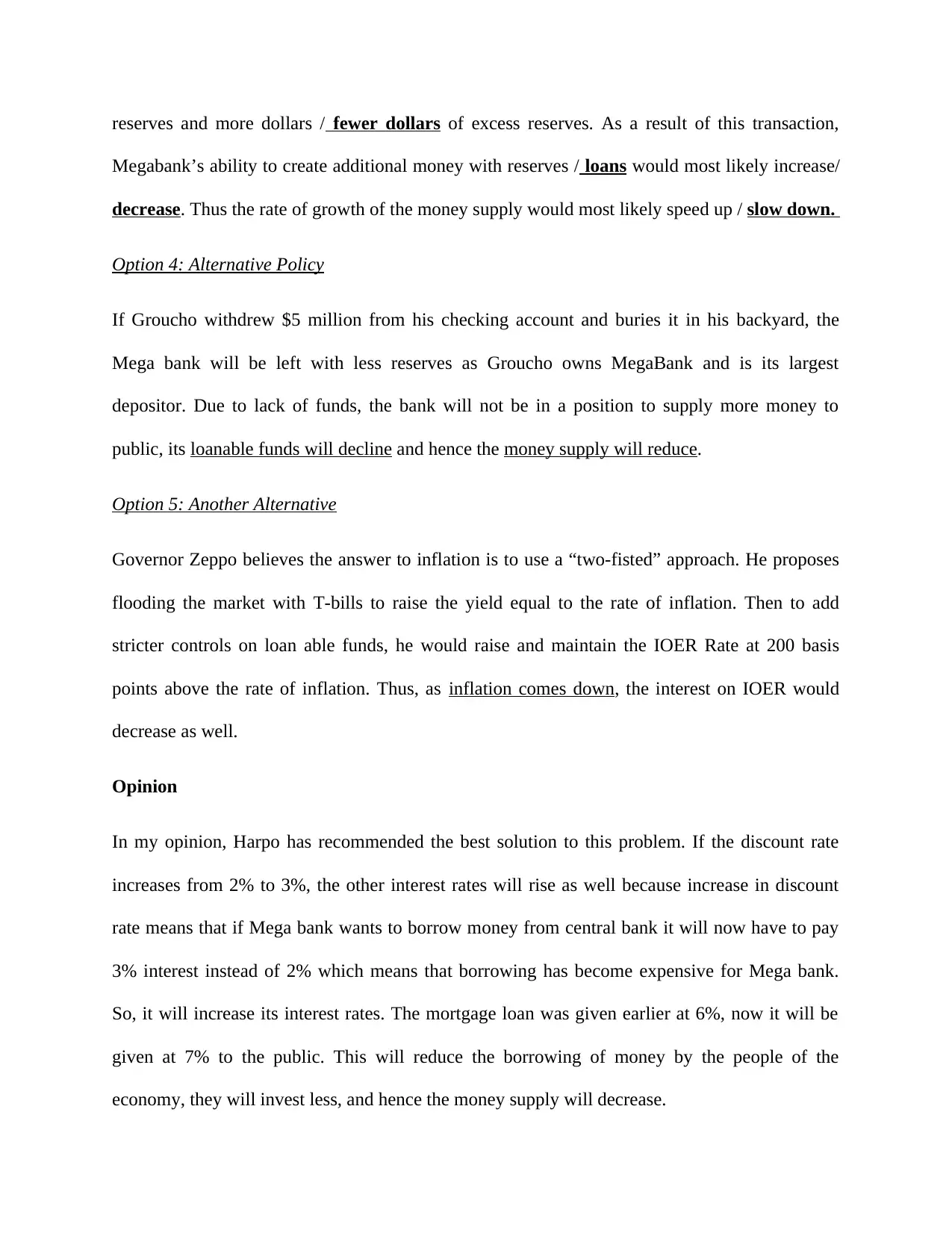
reserves and more dollars / fewer dollars of excess reserves. As a result of this transaction,
Megabank’s ability to create additional money with reserves / loans would most likely increase/
decrease. Thus the rate of growth of the money supply would most likely speed up / slow down.
Option 4: Alternative Policy
If Groucho withdrew $5 million from his checking account and buries it in his backyard, the
Mega bank will be left with less reserves as Groucho owns MegaBank and is its largest
depositor. Due to lack of funds, the bank will not be in a position to supply more money to
public, its loanable funds will decline and hence the money supply will reduce.
Option 5: Another Alternative
Governor Zeppo believes the answer to inflation is to use a “two-fisted” approach. He proposes
flooding the market with T-bills to raise the yield equal to the rate of inflation. Then to add
stricter controls on loan able funds, he would raise and maintain the IOER Rate at 200 basis
points above the rate of inflation. Thus, as inflation comes down, the interest on IOER would
decrease as well.
Opinion
In my opinion, Harpo has recommended the best solution to this problem. If the discount rate
increases from 2% to 3%, the other interest rates will rise as well because increase in discount
rate means that if Mega bank wants to borrow money from central bank it will now have to pay
3% interest instead of 2% which means that borrowing has become expensive for Mega bank.
So, it will increase its interest rates. The mortgage loan was given earlier at 6%, now it will be
given at 7% to the public. This will reduce the borrowing of money by the people of the
economy, they will invest less, and hence the money supply will decrease.
Megabank’s ability to create additional money with reserves / loans would most likely increase/
decrease. Thus the rate of growth of the money supply would most likely speed up / slow down.
Option 4: Alternative Policy
If Groucho withdrew $5 million from his checking account and buries it in his backyard, the
Mega bank will be left with less reserves as Groucho owns MegaBank and is its largest
depositor. Due to lack of funds, the bank will not be in a position to supply more money to
public, its loanable funds will decline and hence the money supply will reduce.
Option 5: Another Alternative
Governor Zeppo believes the answer to inflation is to use a “two-fisted” approach. He proposes
flooding the market with T-bills to raise the yield equal to the rate of inflation. Then to add
stricter controls on loan able funds, he would raise and maintain the IOER Rate at 200 basis
points above the rate of inflation. Thus, as inflation comes down, the interest on IOER would
decrease as well.
Opinion
In my opinion, Harpo has recommended the best solution to this problem. If the discount rate
increases from 2% to 3%, the other interest rates will rise as well because increase in discount
rate means that if Mega bank wants to borrow money from central bank it will now have to pay
3% interest instead of 2% which means that borrowing has become expensive for Mega bank.
So, it will increase its interest rates. The mortgage loan was given earlier at 6%, now it will be
given at 7% to the public. This will reduce the borrowing of money by the people of the
economy, they will invest less, and hence the money supply will decrease.
Paraphrase This Document
Need a fresh take? Get an instant paraphrase of this document with our AI Paraphraser
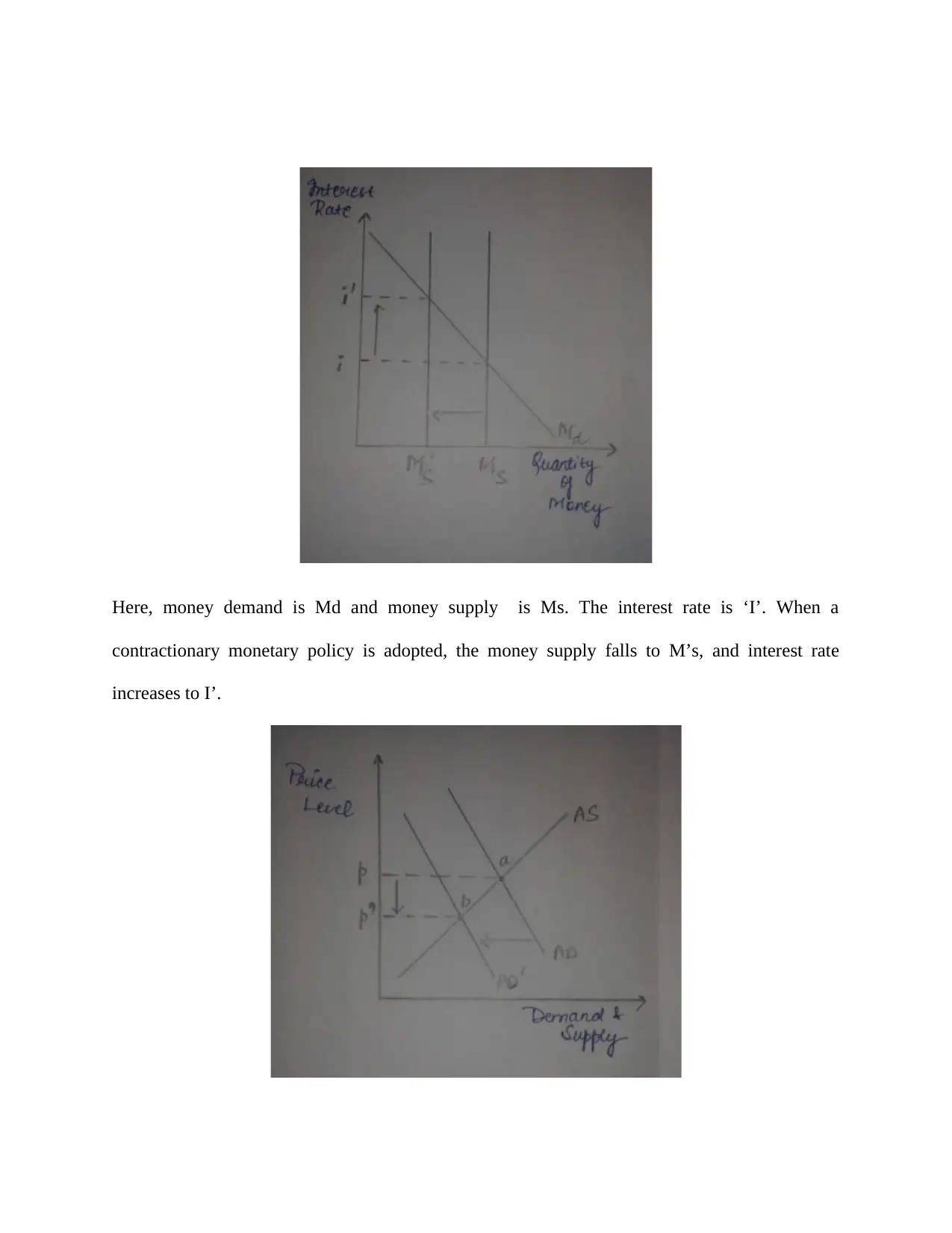
Here, money demand is Md and money supply is Ms. The interest rate is ‘I’. When a
contractionary monetary policy is adopted, the money supply falls to M’s, and interest rate
increases to I’.
contractionary monetary policy is adopted, the money supply falls to M’s, and interest rate
increases to I’.
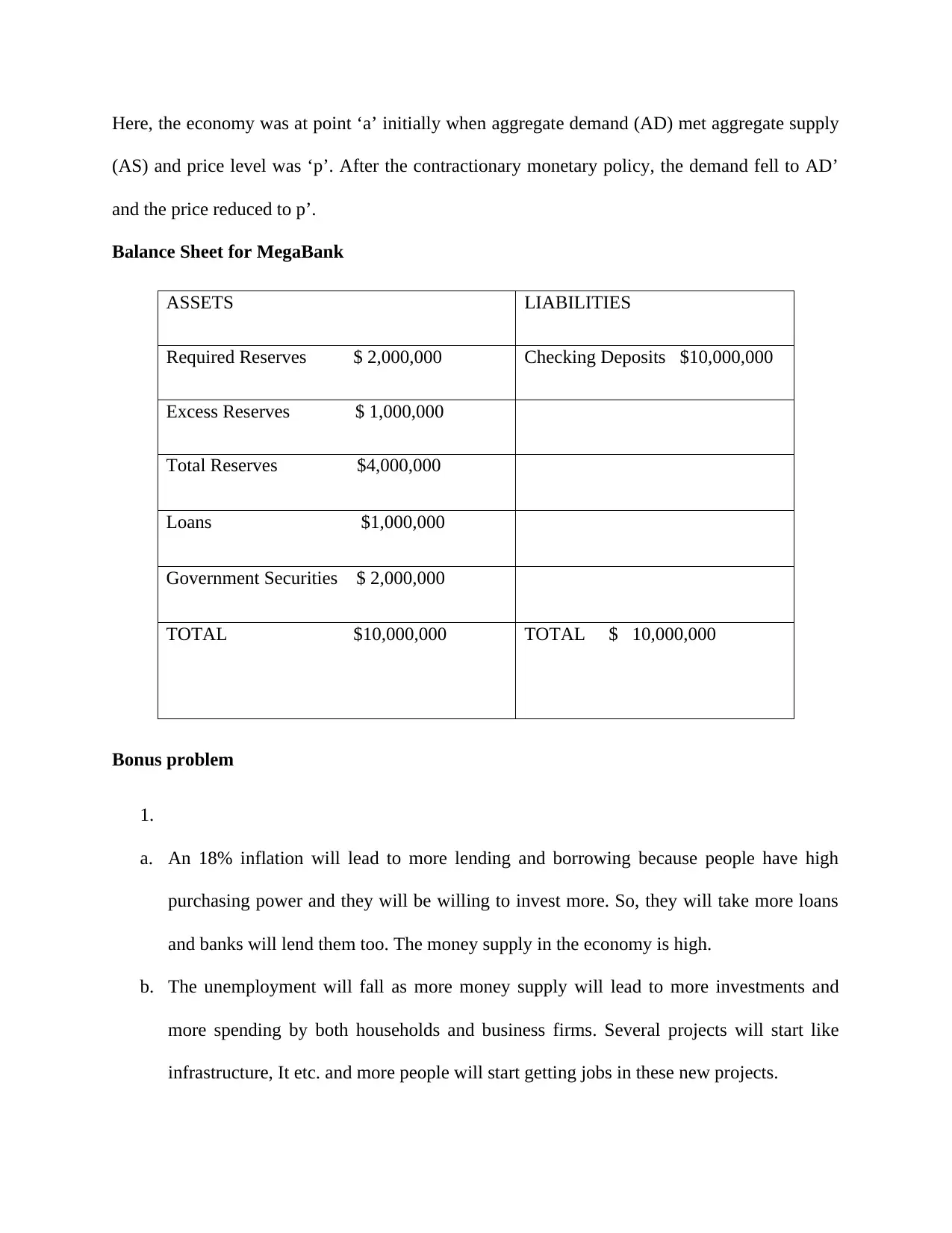
Here, the economy was at point ‘a’ initially when aggregate demand (AD) met aggregate supply
(AS) and price level was ‘p’. After the contractionary monetary policy, the demand fell to AD’
and the price reduced to p’.
Balance Sheet for MegaBank
Bonus problem
1.
a. An 18% inflation will lead to more lending and borrowing because people have high
purchasing power and they will be willing to invest more. So, they will take more loans
and banks will lend them too. The money supply in the economy is high.
b. The unemployment will fall as more money supply will lead to more investments and
more spending by both households and business firms. Several projects will start like
infrastructure, It etc. and more people will start getting jobs in these new projects.
ASSETS LIABILITIES
Required Reserves $ 2,000,000 Checking Deposits $10,000,000
Excess Reserves $ 1,000,000
Total Reserves $4,000,000
Loans $1,000,000
Government Securities $ 2,000,000
TOTAL $10,000,000 TOTAL $ 10,000,000
(AS) and price level was ‘p’. After the contractionary monetary policy, the demand fell to AD’
and the price reduced to p’.
Balance Sheet for MegaBank
Bonus problem
1.
a. An 18% inflation will lead to more lending and borrowing because people have high
purchasing power and they will be willing to invest more. So, they will take more loans
and banks will lend them too. The money supply in the economy is high.
b. The unemployment will fall as more money supply will lead to more investments and
more spending by both households and business firms. Several projects will start like
infrastructure, It etc. and more people will start getting jobs in these new projects.
ASSETS LIABILITIES
Required Reserves $ 2,000,000 Checking Deposits $10,000,000
Excess Reserves $ 1,000,000
Total Reserves $4,000,000
Loans $1,000,000
Government Securities $ 2,000,000
TOTAL $10,000,000 TOTAL $ 10,000,000
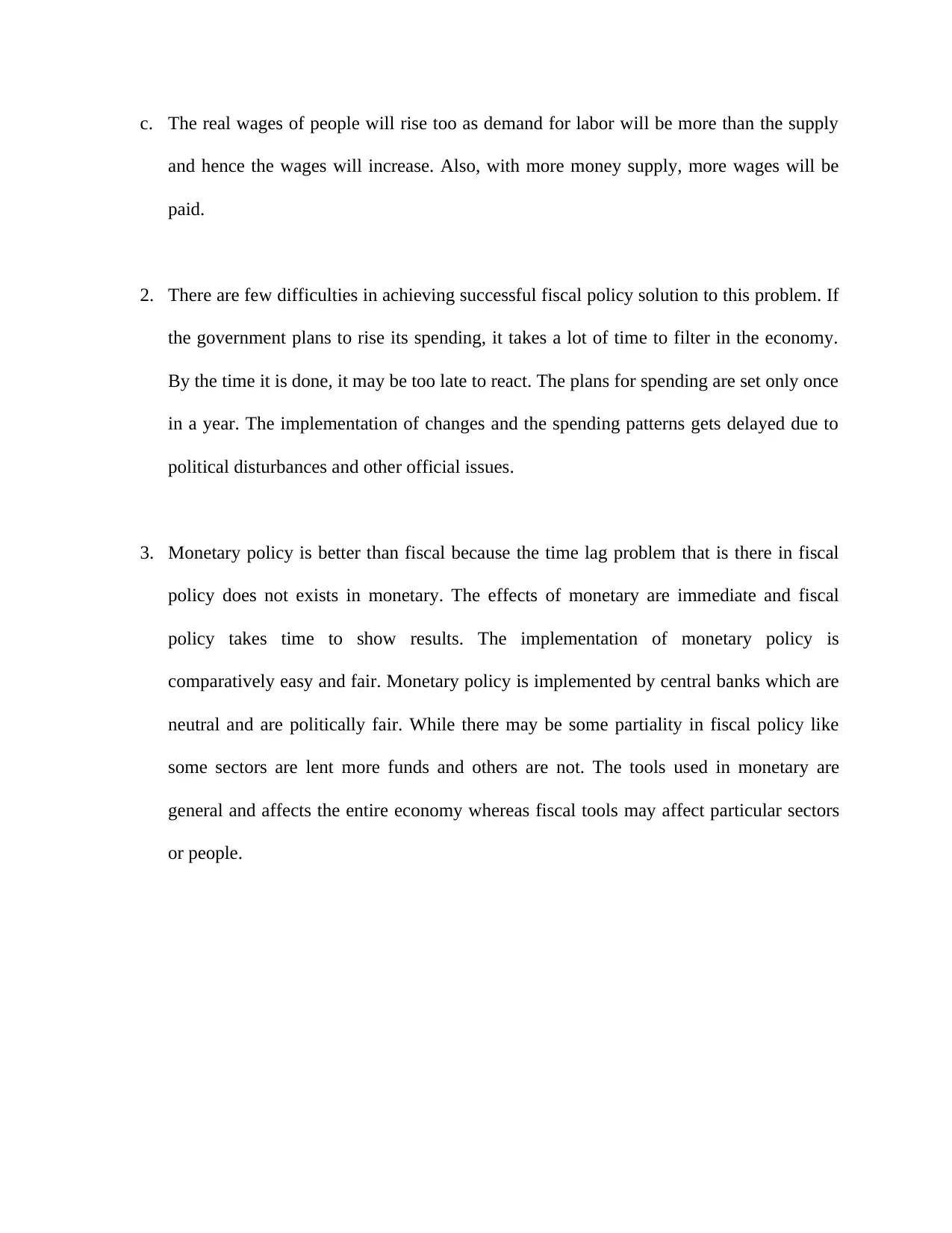
c. The real wages of people will rise too as demand for labor will be more than the supply
and hence the wages will increase. Also, with more money supply, more wages will be
paid.
2. There are few difficulties in achieving successful fiscal policy solution to this problem. If
the government plans to rise its spending, it takes a lot of time to filter in the economy.
By the time it is done, it may be too late to react. The plans for spending are set only once
in a year. The implementation of changes and the spending patterns gets delayed due to
political disturbances and other official issues.
3. Monetary policy is better than fiscal because the time lag problem that is there in fiscal
policy does not exists in monetary. The effects of monetary are immediate and fiscal
policy takes time to show results. The implementation of monetary policy is
comparatively easy and fair. Monetary policy is implemented by central banks which are
neutral and are politically fair. While there may be some partiality in fiscal policy like
some sectors are lent more funds and others are not. The tools used in monetary are
general and affects the entire economy whereas fiscal tools may affect particular sectors
or people.
and hence the wages will increase. Also, with more money supply, more wages will be
paid.
2. There are few difficulties in achieving successful fiscal policy solution to this problem. If
the government plans to rise its spending, it takes a lot of time to filter in the economy.
By the time it is done, it may be too late to react. The plans for spending are set only once
in a year. The implementation of changes and the spending patterns gets delayed due to
political disturbances and other official issues.
3. Monetary policy is better than fiscal because the time lag problem that is there in fiscal
policy does not exists in monetary. The effects of monetary are immediate and fiscal
policy takes time to show results. The implementation of monetary policy is
comparatively easy and fair. Monetary policy is implemented by central banks which are
neutral and are politically fair. While there may be some partiality in fiscal policy like
some sectors are lent more funds and others are not. The tools used in monetary are
general and affects the entire economy whereas fiscal tools may affect particular sectors
or people.
Secure Best Marks with AI Grader
Need help grading? Try our AI Grader for instant feedback on your assignments.
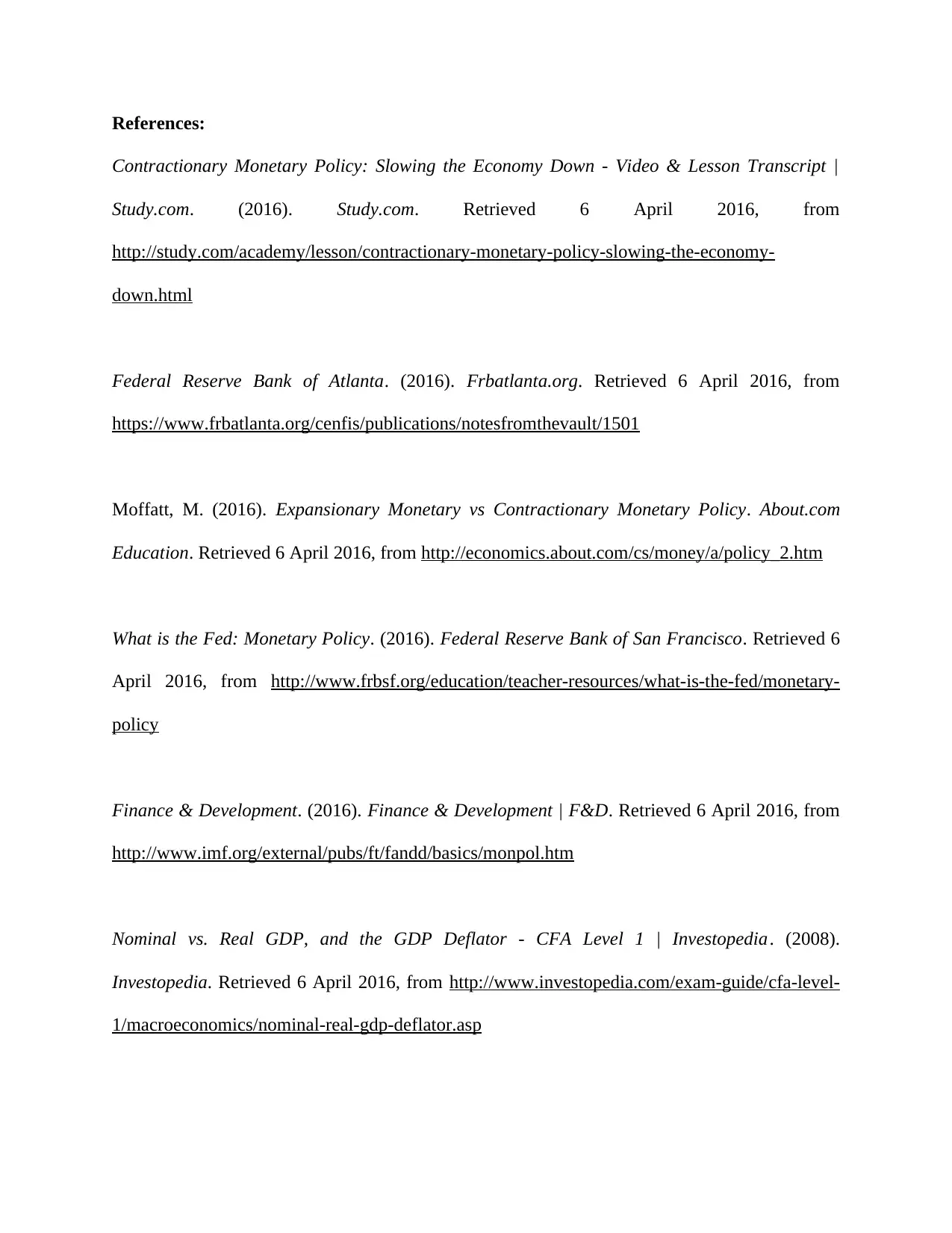
References:
Contractionary Monetary Policy: Slowing the Economy Down - Video & Lesson Transcript |
Study.com. (2016). Study.com. Retrieved 6 April 2016, from
http://study.com/academy/lesson/contractionary-monetary-policy-slowing-the-economy-
down.html
Federal Reserve Bank of Atlanta. (2016). Frbatlanta.org. Retrieved 6 April 2016, from
https://www.frbatlanta.org/cenfis/publications/notesfromthevault/1501
Moffatt, M. (2016). Expansionary Monetary vs Contractionary Monetary Policy. About.com
Education. Retrieved 6 April 2016, from http://economics.about.com/cs/money/a/policy_2.htm
What is the Fed: Monetary Policy. (2016). Federal Reserve Bank of San Francisco. Retrieved 6
April 2016, from http://www.frbsf.org/education/teacher-resources/what-is-the-fed/monetary-
policy
Finance & Development. (2016). Finance & Development | F&D. Retrieved 6 April 2016, from
http://www.imf.org/external/pubs/ft/fandd/basics/monpol.htm
Nominal vs. Real GDP, and the GDP Deflator - CFA Level 1 | Investopedia. (2008).
Investopedia. Retrieved 6 April 2016, from http://www.investopedia.com/exam-guide/cfa-level-
1/macroeconomics/nominal-real-gdp-deflator.asp
Contractionary Monetary Policy: Slowing the Economy Down - Video & Lesson Transcript |
Study.com. (2016). Study.com. Retrieved 6 April 2016, from
http://study.com/academy/lesson/contractionary-monetary-policy-slowing-the-economy-
down.html
Federal Reserve Bank of Atlanta. (2016). Frbatlanta.org. Retrieved 6 April 2016, from
https://www.frbatlanta.org/cenfis/publications/notesfromthevault/1501
Moffatt, M. (2016). Expansionary Monetary vs Contractionary Monetary Policy. About.com
Education. Retrieved 6 April 2016, from http://economics.about.com/cs/money/a/policy_2.htm
What is the Fed: Monetary Policy. (2016). Federal Reserve Bank of San Francisco. Retrieved 6
April 2016, from http://www.frbsf.org/education/teacher-resources/what-is-the-fed/monetary-
policy
Finance & Development. (2016). Finance & Development | F&D. Retrieved 6 April 2016, from
http://www.imf.org/external/pubs/ft/fandd/basics/monpol.htm
Nominal vs. Real GDP, and the GDP Deflator - CFA Level 1 | Investopedia. (2008).
Investopedia. Retrieved 6 April 2016, from http://www.investopedia.com/exam-guide/cfa-level-
1/macroeconomics/nominal-real-gdp-deflator.asp

1 out of 12
Your All-in-One AI-Powered Toolkit for Academic Success.
+13062052269
info@desklib.com
Available 24*7 on WhatsApp / Email
![[object Object]](/_next/static/media/star-bottom.7253800d.svg)
Unlock your academic potential
© 2024 | Zucol Services PVT LTD | All rights reserved.